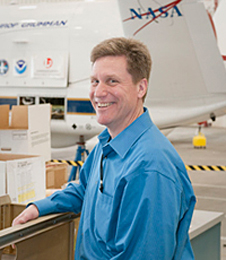|
Paul Newman

Paul Newman studies Earth’s
stratosphere and, particularly, the ozone layer. He is a leader in the use of
airplanes for atmospheric research, and is a senior scientist in the Atmospheric
Chemistry and Dynamics Branch of NASA's Goddard Space Flight Center in
Greenbelt, Md.
Newman is currently a co-chair of the Scientific Assessment Panel for the
Montreal Protocol, the landmark international treaty banning ozone-depleting
substances to protect Earth’s ozone layer.
A native of Seattle, Newman graduated from that city’s O'Dea High School and
earned a bachelor’s degree in physics at Seattle University. He completed his
doctorate in physics at Iowa State University. Newman arrived at NASA Goddard in
1984 as a postdoctoral researcher, and then worked for several years as science
contractor. He became a civil servant scientist in 1990.
Newman has authored or co-authored more than 130 refereed scientific papers and
reports, including several significant studies of atmospheric ozone. He helps
direct Goddard's analysis of the dynamics, chemistry, and radiative properties
of the middle atmosphere.
He has participated in or led more than 15 aircraft field campaigns, including
work in Costa Rica, Sweden, Norway and Alaska. During the SAGE III Ozone Loss
and Validation Experiment (SOLVE), Newman directed the first flight of the NASA
ER-2 over Russia, a civilian version of the U-2 reconnaissance plane that was
converted to scientific research.
Newman is a member of the American Meteorological Society, the American
Geophysical Union, the International Ozone Commission (IOC), and other
international scientific and technical committees. He has been part of ten NASA
Group Achievement awards and has twice been chosen by his Goddard colleagues for
peer awards. In 2002, he was chosen for the Arthur S. Flemming Award presented
by George Washington University. In 2009, he was awarded a Stratospheric Ozone
Protection Award by the Environmental Protection Agency. In 2010, he was named a
Fellow of the American Geophysical Union.
Credit:NASA
|




